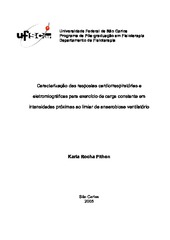Caracterização das respostas cardiorrespiratórias e eletromiográficas para exercícios de carga constante em intensidades próximas ao limiar de anaerobiose ventilatório.
Resumo
This research aimed to identify the ventilatory anaerobic threshold (VAT) in a
ramp continuous test and to apply mathematical and statistical methods to study the
stability of the variables during the exercise performed in discontinuous steps near
the VAT intensity. Eight young men (22,75 ± 2,25 years) were submitted to a ramp
continuous ergoespirometric test (protocol I), with 20 to 25 W.min-1 power
increments, on an electromagnetic braked cycle ergometer and to 3 discontinuous
steps (protocol II), each one lasting 15 minutes, with 70% of VAT (step 1), 100% of
VAT (step 2) and 130% of VAT (step 3). The metabolic and ventilatory variables
( O2, CO2, E, PetO2, PetCO2) were collected on a breath-by-breath basis, heart
rate (HR) was collected on a beat-to-beat basis, and RMS was calculated for the
myoelectrical signal of vastus lateralis muscle. In protocol I, VAT was determined by
the loss of parallelism between O2 and CO2; in protocol II data a semi-parametric
mathematical and statistical model was applied. For statistical analysis the median
confidence interval was applied, α= 5% and descriptive analysis. HR was statistically
different between VAT and step 3 and among steps 1, 2 and 3. For O2, CO2 and
E data the results were similar, with significant statistical differences between VAT
and steps 2 and 3 and among the three steps. For PetO2 the statistical difference
was observed between VAT and step 3; PetCO2 and RMS did not show statistical
differences. The analysis of the 3o to 9o minute (T1) and of the 9o to 15o minute (T2)
of the steps, showed for step 1: for HR 7 stables (S) and 1 crescent (C) and O2 and
CO2 8S in T1 and T2; PetCO2 7S and 1 decreasing (D) in T1 and 7S and 1C in T2;
PetO2 5S and 3C in T1 and 7S and 1D in T2; RMS 4S, 3D and 1C in T1 and 7S and
1D in T2. For step 2: HR 3S and 5C in T1 and 5S and 3C in T2; O2 and CO2 8S
in T1 and T2; PetCO2 4S and 4D in T1 and 5S and 3D in T2; PetO2 5S and 3C in T1
and 8S in T2; RMS 4S, 2D and 2C. For step 3: HR 8C in T1 and 5S and 3C in T2,
CO2 8S and O2 7S and 1C in T1 and O2 and CO2 8S in T2; PetCO2 1S and
7C in T1 and 5S, 1C and 2D in T2; PetO2 4S and 4C in T1 and 5S, 2D and 1C in T2;
RMS 4S, 2D and 2C in T1 and 4S, 3D and 1C in T2. Conclusions: for young
volunteers, on a step protocol, it is necessary to decrease the power intensity around
30% to reach similar cardiorrespiratory values of VAT. PetCO2 and HR showed more
sensitive responses to power intensities above VAT and can be used as first
signaling of exercise above VAT.
